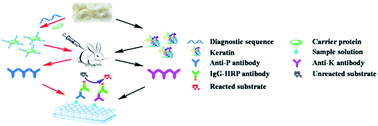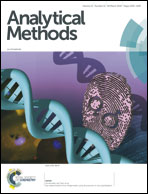Preparation of artificial antibodies and development of an antibody-based indirect ELISA for the detection of ancient wool†
Abstract
The use of wool from sheep is widespread in ancient and historic textiles. The detection of ancient wool can provide meaningful information for both archaeologists and academics. However, the efficacy of conventional methods is likely to be limited in the detection of ancient samples with severe degradation or contamination. This is also one of the main challenges in archaeological sites. In this study, a novel immunological approach was proposed to overcome this difficulty. Two diagnostic antibodies, the anti-K (keratin) antibody and the anti-P (peptide) antibody, were carefully designed and prepared through the immunization of animals with a complete antigen (keratin) and the conjugation product of hapten (diagnostic peptide) with a carrier protein, respectively. Next, an indirect enzyme-linked immunosorbent assay (ELISA) was established under the optimal binding concentration of the coating antigens and the antibodies. The results indicated that the antibody-based immunological method exhibited high sensitivity, specificity and reliability. The limit of detection in the ELISA for the anti-K and anti-P antibodies was 81.39 ng mL−1 and 6.81 ng mL−1, respectively. The ELISA revealed a lower cross-reactivity (less than 0.01%) for the two antibodies with interference antigens. The recoveries of the two antibodies from standard soil samples were in the range of 80% to 100%, with a relative standard deviation (RSD) of lower than 9%. The coefficients of variation for the anti-K antibody and anti-P antibody were in the range of 3.27% to 12.40% and 9.48% to 10.31%, respectively. Moreover, both the anti-K and anti-P antibodies can positively identify ancient wool samples, even for wool traces in soil, verifying the validity and practicability of the immunological method in the detection of ancient wool.



 Please wait while we load your content...
Please wait while we load your content...